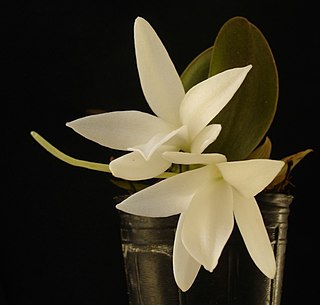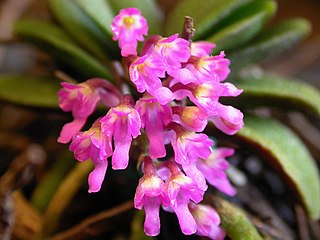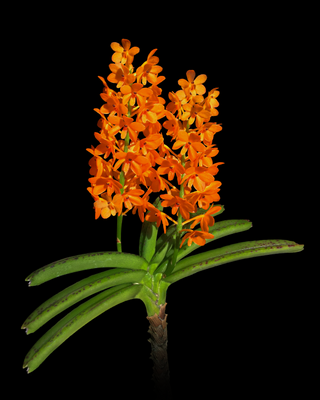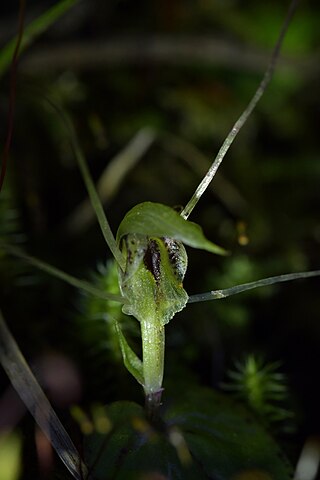
Orchids are plants that belong to the family Orchidaceae, a diverse and widespread group of flowering plants with blooms that are often colourful and fragrant.

Vanda, abbreviated in the horticultural trade as V., is a genus in the orchid family, Orchidaceae. There are about 87 species, and the genus is commonly cultivated for the marketplace. This genus and its allies are considered to be among the most specifically adapted of all orchids within the Orchidaceae. The genus is highly prized in horticulture for its showy, fragrant, long-lasting, and intensely colorful flowers. Vanda species are widespread across East Asia, Southeast Asia, and New Guinea, with a few species extending into Queensland and some of the islands of the western Pacific.

Cypripedioideae is a subfamily of orchids commonly known as lady's slipper orchids, lady slipper orchids or slipper orchids. Cypripedioideae includes the genera Cypripedium, Mexipedium, Paphiopedilum, Phragmipedium and Selenipedium. They are characterised by the slipper-shaped pouches of the flowers – the pouch traps insects so they are forced to climb up past the staminode, behind which they collect or deposit pollinia, thus fertilizing the flower. There are approximately 165 species in the subfamily.

Aerangis, abbreviated as Aergs in horticultural trade, is a genus of the Orchid family (Orchidaceae). The name of this genus has been derived from the Greek words 'aer' (air) and 'angos' (urn), referring to the form of the lip. It is the type genus of the subtribe Aerangidinae, which has recently been subsumed in the subtribe Angraecinae. Approximately 50 species in this genus are known mostly from tropical Africa, but also from the Comoro Islands, Madagascar and Sri Lanka.

Trichocentrum, often abbreviated Trctm in horticulture, is a genus in the orchid family, Orchidaceae. Dancinglady orchid is a common name for plants in this genus. It was described by Stephan Ladislaus Endlicher and Eduard Friedrich Poeppig in 1836. This genus alone makes up the monogeneric Trichocentrum alliance, a quite distinct lineage of the subtribe Oncidiinae.

Holcoglossum (Holc.) is a genus of orchids, in the family Orchidaceae. It is native to China and Southeast Asia.

Vanda cristata is a species of orchid found growing in the Himalaya from Bangladesh, India, Nepal, Bhutan to China at elevations of 600 – 2300 meters.

Vanda tessellata is a species of orchid occurring from the Indian subcontinent to Indochina. It is a medicinal plant.

Papilionanthe Miss Joaquim, also known as the Singapore orchid, the Princess Aloha orchid and formerly as Vanda Miss Joaquim, is a hybrid orchid that is the national flower of Singapore. For its resilience and year-round blooming quality, it was chosen on 15 April 1981 to represent Singapore's uniqueness and hybrid culture.

Traunsteinera, the round headed orchid, or globe orchid, is a genus of flowering plants from the orchid family, Orchidaceae.

Schoenorchis, commonly known as flea orchids, or 匙唇兰属 in Chinese, is a genus of flowering plants from the orchid family, Orchidaceae. Plants in this genus are small epiphytes with thin roots, thin leafy stems with leaves in two ranks and tiny fragrant, almost tube-shaped flowers with a prominently spurred labellum. There are about twenty five species found from tropical and subtropical Asia to the Western Pacific.

Caleana, commonly known as duck orchids, is a genus of flowering plants in the orchid family, Orchidaceae that is found in Australia and New Zealand. The Australian species are found in all states but have not been recorded in the Northern Territory. Duck orchids have a single leaf and one or a few, dull-coloured, inconspicuous flowers. Most species are found in Western Australia but one species occurs in eastern Australia and one occurs in eastern Australia and New Zealand. Orchids in this genus as well as the hammer orchids (Drakaea) are pollinated by male thynnid wasps.

Vanda garayi, or Garay's ascocentrum, is a small monopodial epiphytic orchid native to semi-deciduous and deciduous dry lowland forests of Thailand, Laos, and Sumatra.

Bartholina burmanniana, the spider orchid, is a species of deciduous, geophytic, flowering plant in the family Orchidaceae. It is one of two species within the Bartholina genus, the other being B. etheliae. The species’ common name refers to its spreading and deeply cut lip that is said to resemble a spider's legs. It is native to the Eastern and the Western Cape Provinces of South Africa, flowering from the end of August to the middle of October and peaking in September. This is one of the species sometimes referred to as "spider orchid".

Papilionanthe uniflora is a species of epiphytic orchid native to India, Myanmar, Bhutan and Nepal.
Papilionanthe biswasiana is a species of epiphytic orchid native to Laos, China, Myanmar, and Thailand. It is closely related to Papilionanthe vandarum.

Papilionanthe tricuspidata is a species of epiphytic orchid endemic to the Lesser Sunda Islands, Indonesia. Its status remains an enigma and some individuals were identified as hybrids involving Papilionanthe teres. The species was described as difficult to flower and only producing small flowers. It occurs sympatric with Vanda limbata and supposedly with "Vanda purpurea", which does not appear to be any known species or synonym. Like all members of the genus, this species bears terete leaves on a slender stem.

Phalaenopsis hygrochila, also known as 湿唇兰 in Chinese, is a species of epiphytic orchid native to Assam, Borneo, China South-Central, China Southeast, East Himalaya, Laos, Malaya, Myanmar, Bangladesh, Nepal, Sumatera, Thailand, Vietnam and West Himalaya.

Vanda dives is a species of epiphytic orchid native to Vietnam and Laos.

Corybas papa is a species of terrestrial orchid endemic to the North Island of New Zealand. It has a solitary wedge-shaped leaf and single translucent green flower with a strongly deflexed labellum and slender, threadlike lateral sepals and petals.
























